Iowa, a Midwestern state in the U.S, boasts fertile plains and rolling hills, making it one of the nation’s leading agricultural states. The Hawkeye state experiences a humid continental climate, with warm summers, cold winters, and moderate to high precipitation throughout the year.

These conditions, combined with nutrient-rich soils, provide the perfect environment for weeds to thrive. From agricultural fields to home gardens and roadsides, these weeds can spread rapidly, competing with crops and ornamental plants for sunlight, water, and nutrients.
Below is a list of the most common weeds in Iowa, complete with their scientific names, physical descriptions, and pictures.
1. Common Lambsquarters (Chenopodium album)
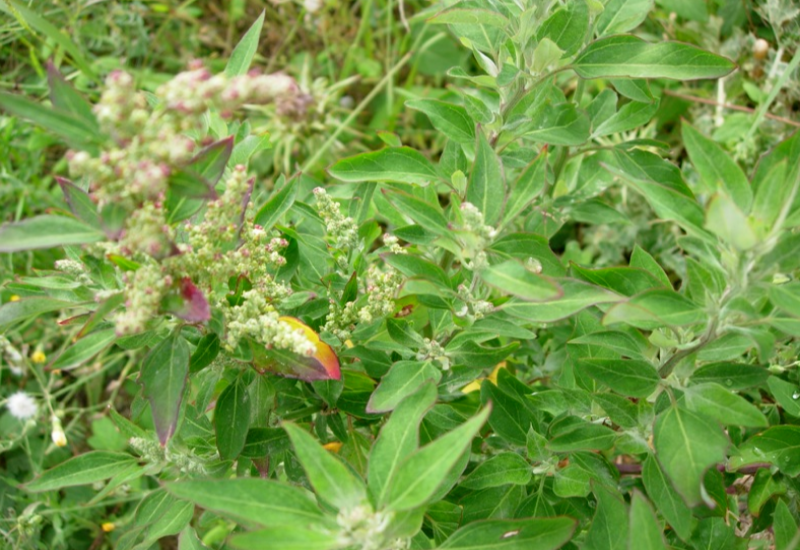
- Local Name: Common Lambsquarters
- Family: Amaranthaceae
- Annual or Perennial: Annual
Common Lambsquarters is an erect weed that grows 5-6 feet tall. It can be identified by its triangular to lanceolate leaves, wax-layered stems, and clusters of flowers on terminal panicles.
This annual plant is a prolific seed producer, an early germinator, and quick-growing, making it a serious weed of gardens, crop fields, roadsides, and other disturbed areas.
Increased seeding rate, crop rotation, and growing of cover crops in fall are some of the cultural measures recommended to discourage weed growth. Well-timed tillage in crop fields before planting and cleaning of nearby areas can also prevent seed germination.
There are several groups of herbicides indicated for control depending on the infested area. Consult an extension expert for the best chemical strategy for your field or landscape.
2. Velvetleaf (Abutilon theophrasti)
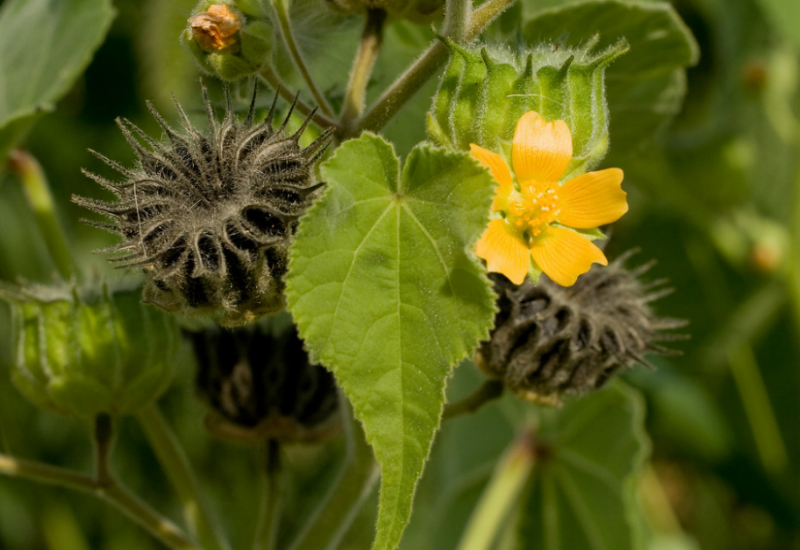
- Local Name: Velvetleaf, Elephant Ears, Buttonweed, or Butterprint
- Family: Malvaceae
- Annual or Perennial: Annual
Velvetleaf is a native of South Asia and was brought to North America as an alternative fiber crop. Since then, it has become a problematic weed in crop fields, costing farmers thousands of dollars in achieving effective control.
You can identify the plant by its heart-shaped leaves, about 4-8 inches wide. The leaves and stems are covered in short, soft hairs, giving them a velvety feel, hence the name.
Velvetleaf is a noxious weed in Iowa crop fields but can also be found in ditches, disturbed areas, and roadsides.
Cover cropping, crop rotation, and tillage combined with herbicide applications have provided effective weed control in cash crop systems.
3. Smooth Crabgrass (Digitaria ischaemum)
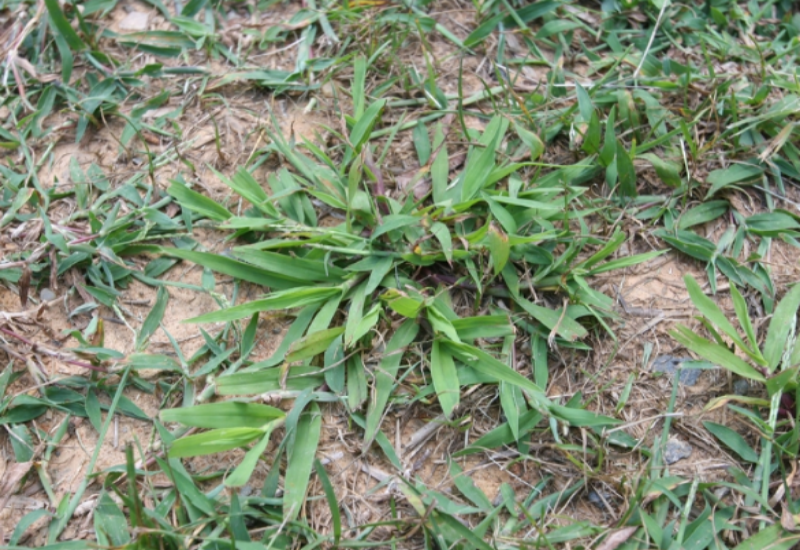
- Local Name: Smooth Crabgrass or Crabgrass
- Family: Poaceae
- Annual or Perennial: Annual
Smooth crabgrass is a common weed in Iowa lawns. It emerges in spring, producing light green foliage and finger-like seedheads in late summer.
Since this grass species can produce thousands of seeds, grow in poor soil and weather conditions, it is also a problematic weed in horticultural and agronomic settings, vegetable gardens, and other landscapes.
Apply a preemergence herbicide like siduron, benefin, bensulide, pendimethalin, or dithiopyr to prevent crabgrass emergence. For existing infestations in different turfgrasses, apply postemergent herbicides including mesotrione, fenoxaprop, topramezone, and quinclorac for effective control.
4. Pokeweed (Phytolaca americana)
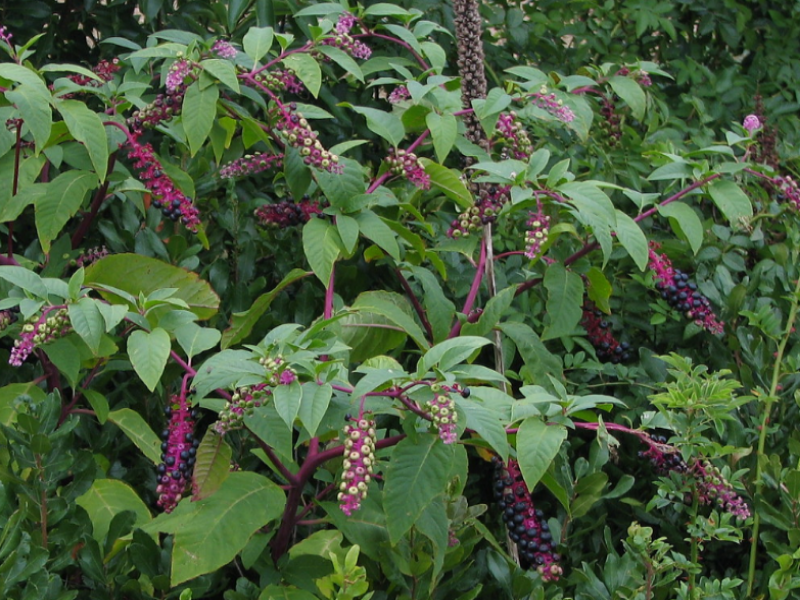
- Local Name: Pokeweed or Common Pokeweed
- Family: Phytolaccaceae
- Annual or Perennial: Perennial
Pokeweed is a large herbaceous weed that grows up to 9 feet tall. It can be easily identified by its red or purple stems, large, lanceolate to ovate leaves, and dark purple berries.
In Iowa, the heavily branched plant is a common weed of landscapes, no-till fields, and waste areas.
Dig out the plants from the roots or apply herbicides like 2,4-D, dicamba, and glyphosate, depending on the size of the infestation.
5. Japanese Knotweed (Fallopia japonica)

- Local Name: Japanese Knotweed or Japanese Bamboo
- Family: Polygonaceae
- Annual or Perennial: Perennial
Japanese Knotweed is an erect perennial that grows in dense patches, with the stems reaching heights of 6 feet. It is identified by its bamboo-like stems, ovate leaves, and white flowers borne in dense clusters on leaf axils.
The weed was introduced as a garden ornamental but quickly became an invasive weed in crop fields, roadsides, streambanks, and other waste areas.
Remove the small colonies of the weeds as soon as you discover them. You can also utilize organic methods, make repeat cuttings during the growing season, or inject herbicides like imazapyr, 2,4-D amine, or glyphosate into stem cuttings to achieve weed dieback.
6. Giant Foxtail (Setaria faberi)

- Local Name: Giant Foxtail
- Family: Poaceae
- Annual or Perennial: Annual
Giant Foxtail is native to China and was first discovered in Iowa in 1949. It can grow up to four feet tall, producing leaves with short hairs, round upright stems, and a cylindrical seedhead that droops in maturity.
This foxtail species is mostly found in turf, landscapes, and disturbed sites. It is also a particularly problematic weed in crop fields such as corn, soybean, and canola, and vegetable gardens.
Moderate to heavy cover cropping and crop rotation provide the best weed reduction results.
Several preemergence and postemergence herbicides are indicated for Giant Foxtail based on the crop or area of infestation. They include atrazine, quizaloxdasqfop, glyphosate, and quinclorac.
7. Poison Ivy (Toxicodendron radicans)

- Local Name: Poison Ivy
- Family: Anacardiacaceae
- Annual or Perennial: Perennial
Poison Ivy is a native woody perennial that can grow as a shrub or a climbing plant on buildings, fences, and trees. You can easily identify it by its leaves, which have three shiny leaflets.
The leaves are the most associated with allergic skin reactions. However, all its parts contain urushiol, the compound that causes dermatitis.
It reproduces by seeds and creeping roots and thrives in field borders and woodland edges. However, it is also found in ornamental landscapes, pastures, and noncrop lands.
Removing Poison Ivy requires a systematic approach. First, make cuttings or clippings of the plants near the ground level and allow them to dry.
Dig up the roots and mats from the ground and dispose of them properly. For the remaining roots, apply a non-selective herbicide like glyphosate or triclopyr for the best results.
8. Field Bindweed (Convolvulus arvensis)
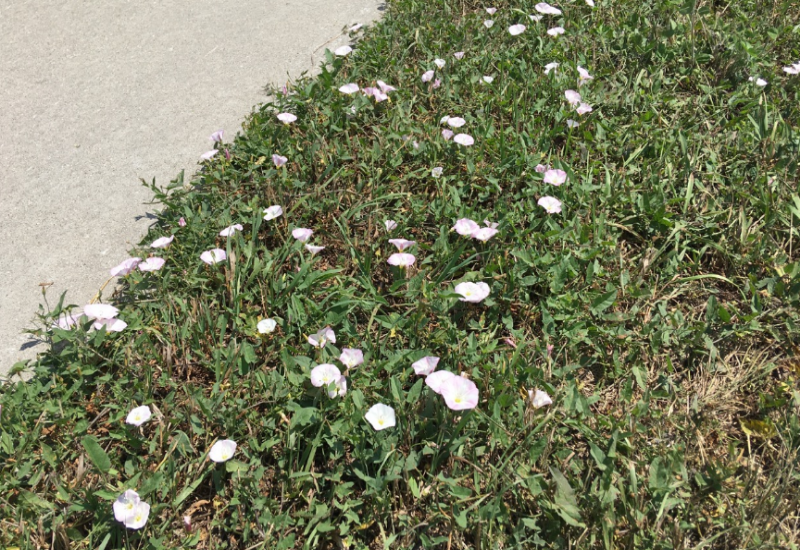
- Local Name: Field Bindweed or Creeping Jenny
- Family: Convovulaceae
- Annual or Perennial: Perennial
Field Bindweed is native to Europe and Asia. Today, it is widely found in the Northwestern parts of Iowa, invading low-maintenance turf, crop fields, fence lines, and other landscapes.
It is identified by its twining vines, lanceolate leaves, oppositely arranged on the stems, and white to pink, funnel-shaped flowers with two separate, tiny bracts.
The weed also produces extensive underground rootstocks that can grow up to 20 feet deep, making it one of the most difficult-to-control weeds if left to establish.
Field Bindweed removal calls for an integrated management system. Remove small infestations by hand-pulling. Repeated deep tillage is viable to help deplete the weeds’ resources and prevent further spread.
For persistent plants, herbicides like glyphosate, 2,4-D, quinclorac and others can suppress the weed in different settings.
9. Dandelion (Taraxacum officinale)
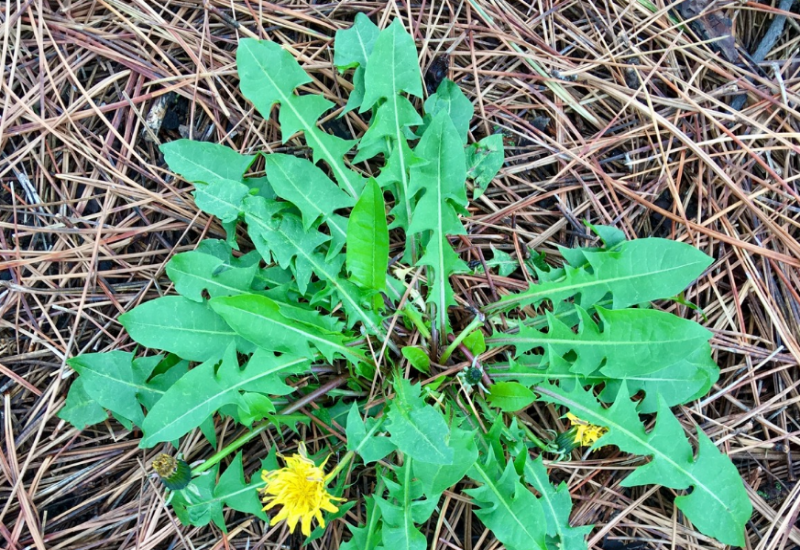
- Local Name: Dandelion or Common Dandelion
- Family: Asteraceae
- Annual or Perennial: Perennial
Dandelion is a common weed in turf, pastures, and agricultural fields in Iowa. The broadleaf weed produces deeply toothed leaves that form a rosette about 1.5 feet wide and solitary flower heads with showy yellow flowers.
Dandelion’s ability to thrive in a variety of conditions, efficiently produce and disperse seeds, and grow a deep taproot, makes it a routine weed to deal with every year.
You can prevent further spread in residential lawns and home gardens by hand-pulling or using digging tools to remove the weeds when they are young. Ensure that the taproot is removed to prevent regrowth.
Spot spraying with herbicides like triclopyr, dicamba, glyphosate, or iron HEDTA can provide better control for larger infestations.
10. Creeping Charlie (Glechoma hederacea)
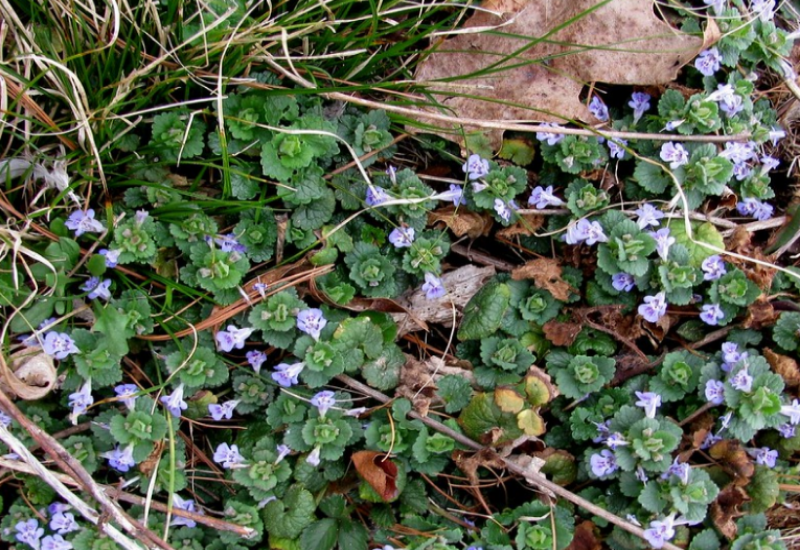
- Local Name: Creeping Charlie or Ground Ivy
- Family: Lamiaceae
- Annual or Perennial: Perennial
The creeping or prostrate perennial was initially introduced in North America as a salad green and medicinal herb. Today, it is one of the most common and problematic weeds in Iowa lawns.
It has rounded leaves with scalloped edges, square stems that root at the nodes, and tubular, blue to purple flowers. The weed propagates by seeds and creeping stems, aggressively spreading over large areas.
Maintaining a healthy turf is the best strategy to prevent a Creeping Charlie encroachment. For small patches, remove the weed by hand and repeat as required. Ensure that you remove the shoots and roots to prevent regrowth. A triclopyr application in the fall is effective for large patches.
11. Bush Honeysuckle (Lonicera maackii)

- Local Name: Bush Honeysuckle
- Family: Caprifoliaceae
- Annual or Perennial: Perennial
Bush Honeysuckle is an upright, woody perennial that grows 6-15 feet tall. It was introduced from Asia as an ornamental but has quickly become an invasive shrub in woodlands, roadsides, pastures, and abandoned fields.
This honeysuckle species grows as a dense, multi-stemmed bush, crowding understory plants. It is also noted to have allelopathic properties that can hinder the growth of native plants.
Manual pulling is a viable option for small seedlings, while larger plants can be pulled out with strong weed wrenches. Glyphosate, picloram, 2,4-D, or triclopyr-amine can be applied on the foliage, cut stumps, or applied from an aerial view for the best results.
12. Wild Violet (Viola sororia)
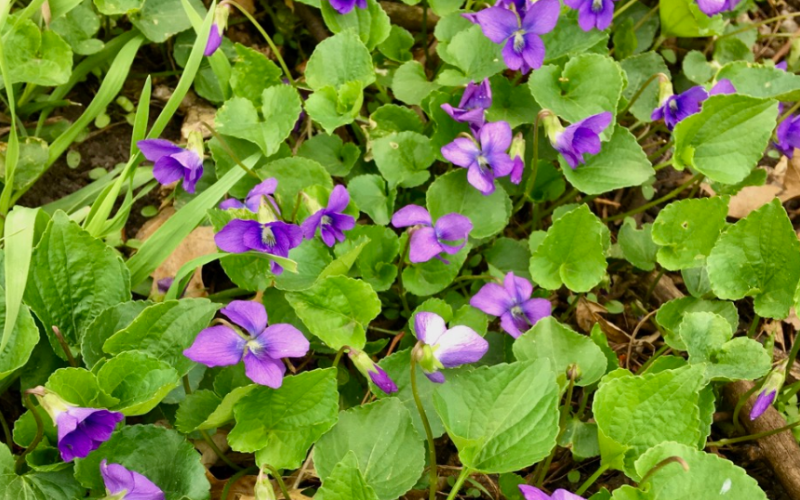
- Local Name: Wild Violet or Common Blue Violet
- Family: Violaceae
- Annual or Perennial: Perennial
Common Blue Violet is among the common violets in the state. This specific species is mainly found in lawns and wooded areas.
You can identify the weed by ovate to heart-shaped leaves, emerging from a basal crown, and showy, 5-petaled, blue to purple flowers.
Wild Violet reproduces by seeds and short rhizomes, forming dense colonies that can outcompete turf and other desirable plants.
Repeated hand removal is effective for small patches if all rhizomes and roots are removed. Maintaining a dense, healthy turf can discourage Wild Violet encroachment.
Applications of herbicides like glyphosate, 2,4-D, or triclopyr can also provide effective control. However, repeat applications are necessary due to the leaf’s waxy surface.

Lead Editor for Insight Weeds.